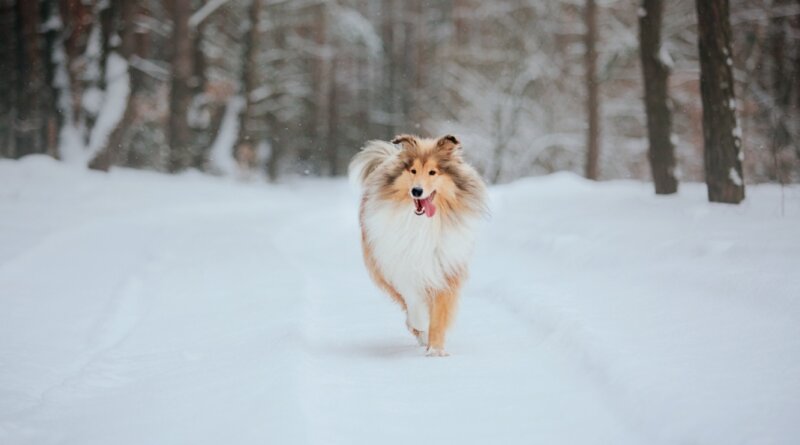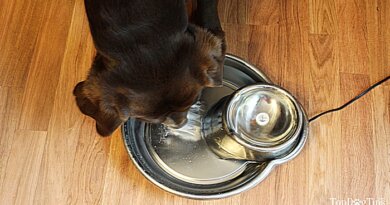7 Winter Safety Tips for Pet Owners – Top Dog Tips
Taking care of a dog is a lot of work, and it can be even harder in the winter months. Depending on your dog’s size, coat type and age, cold temperatures could be a major concern. The weather will also pose it’s own set of challenges. From snow, cold temperatures and the dangers of the holiday season, there are many winter safety tips for pet owners that you need to be aware of.
It’s easier for pets and their people to start feeling trapped inside during the winter months. Even when it’s too cold to play outside, your dog still needs a lot of attention and exercise. Your dog’s health and safety are always top priorities, but it’s even more important to focus on these issues in the winter months.
Be aware of your dog’s comfort. How long can he stay out in the cold? Small breeds, senior dogs, puppies and breeds with little to no fur will get cold quickly if they’re not dressed for the elements. Be aware of the dangers that winter brings like icy walkways, dangerous ice melting chemicals and frozen water.
As long as you stay alert, keep your pet’s safety in mind and follow these winter safety tips for pet owners, you and your Fido will have a safe and fun winter!
7 Winter Safety Tips for Pet Owners
1. Keep indoors when possible
The most obvious winter safety tips for pet owners is to learn when it’s too cold for dogs to go outside. This means considering the temperature outside, accounting for the wind chill factor, and knowing what other weather conditions are expected.
When it’s 20˚F outside, it’s too cold for most dogs. Above 20˚F it may still be too cold to walk if conditions are icy, windy or if your dog is very young, old or has a compromised immune system. If it is safe to go out, make sure to keep walks short and keep your pup wrapped up warm with their feet protected.
Do not leave your dog outside for long periods of time. When you do need to leave him outside, make sure your pet has a shelter that is built for the weather conditions. The shelter needs to be weather tight, and it should be elevated off the ground at least a few inches. Outdoor shelters need to be large enough for Fido to be comfortable yet small enough to retain as much body heat as possible.
If possible, the shelter should be insulated. It needs to face away from winds, and the entrance should be covered with a heavy duty flap that keeps out the elements. You also need to provide warm bedding for your pet to help him stay comfortable when the temperatures get cold.
If your dog is left outdoors for long periods of time, his body is going to need more calories to produce extra body heat. For this reason, you need to provide extra food and make sure there is fresh, thawed water available at all times.
2. Paw care
One of the many winter dangers that pet owners need to be aware of is toxic chemicals that are spread to prevent ice build up. These chemicals can absorb into your dog’s paws, irritating the skin. They may also become ingested if your dog licks his paws when you get back home.
Sharp ice pieces or objects hidden under the snow can be dangerous to your dog’s paws, too. Protect your pup’s paws with winter booties or protective waxes. If you choose to use paw wax, you’ll need to clean his paws when you return home from your daily walks.
You’ll need to wipe salt and other ice melting chemicals off your dog’s paws with grooming wipes or warm water. You’ll also want to wipe down his belly, because chemicals will fling up onto his abdomen as he walks and runs. This is another reason why it’s a good idea to equip your pet with boots. It’s also important to check your dog’s paws regularly for signs of severe cold or irritation from chemicals.
SIMILAR: Do Dogs Sleep More in Winter Time?
3. No short haircuts
Do not shave your pet in winter months. You can trim his coat, but leave it a little bit longer than normal for warmth. That doesn’t mean that you can’t groom your pup in winter, but it does mean that you shouldn’t go for those close-clipped, nearly-naked cuts.
Your dog relies on his coat for insulation against the cold and when you remove a large portion of it, he won’t be able to keep himself warm. If you’re wondering if his haircut is too short, consult your veterinarian or a local groomer.
4. Leash-only around water
Take it from someone who lives on a river, frozen water can be incredibly dangerous! Whether it’s standing water, like a lake or pond, or moving water, it’s important to keep your dog on a leash at all times when walking near any body of water. Even if it’s been cold for months and you think the ice is thick enough to support your dog, there could be thin spots or cracks in the ice that you don’t realize.
5. Do not leave your pet in the car
We often hear about the dangers of leaving pets in the car when it’s hot outside. It’s just as important to leave your dog at home when it’s cold outside. Some owners think that it’s okay to leave their pet’s in the car with the vehicle running and the heat, but that is just as dangerous. Your could overheat if the vehicle gets too hot. The best thing to do is just leave your pet at home when you’re going to be running errands.
6. Check your vehicle
This is one of my winter safety tips for pet owners that applies to everyone. Check your vehicle before starting it. If you have outdoor cats or stray cats in your area, they may look for shelter in the engine compartment of vehicles. Your car’s engine gets hot when it’s running, and as it cools down the engine compartment of your vehicle will turn into a warm shelter for small animals.
Bang on the hood of your car a couple of times before starting it. This will startle any animals in or underneath your vehicle and allow them time to escape before you start the engine.
7. Pay attention to antifreeze
Antifreeze is extremely toxic for all pets. Just a small amount can cause kidney failure. Unfortunately, antifreeze has a sweet smell that attracts animals. If you’re filling your vehicle with coolant, be careful not to spill any on the ground or in your garage.
As I said, a very small amount of antifreeze can be fatal to pets. A cat or small dog could ingest enough antifreeze to poison them just by licking their paws after walking through a puddle of the coolant. If your pet accidentally ingests antifreeze, call your veterinarian immediately or head for the nearest emergency vet. In this case, waiting just a few minutes could mean the difference between life and death.
READ NEXT: 17 Reasons Why Keeping Dogs Outside in Winter Is A Bad Idea
Related






